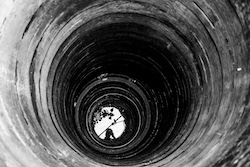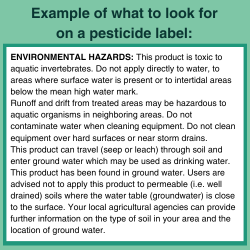How do I keep pesticides out of my well water?
1.800.858.7378npic@oregonstate.edu
We're open from 8:00AM to 12:00PM Pacific Time, Mon-Fri
A to Z

How do pesticides get into well water?
Some pesticides can travel down through the soil and end up in the groundwater. When we draw that water into a well, we may end up with contaminated well water.
What chemical characteristics influence risk?

Pesticides that are most likely to travel through the soil have the greatest risk of contaminating groundwater and well water. If the pesticide is soluble (dissolves) in water and does not break down quickly in the environment, it poses a higher risk.
Some pesticides will bind tightly to soil or sediment. These are not likely to find their way into water unless the soil itself washes into surface waters.
Pesticides break down from exposure to sunlight, water, or bacteria. How long it takes for this to occur in the environment is called the half life. If the pesticide breaks down more quickly than it moves through the soil, the risk to well water is lower than if the pesticide lasts a long time and moves easily through soil.
Soil type affects movement. Sandy soils with little organic matter will allow faster pesticide movement than heavy, dense soils with a lot of organic matter.
What site characteristics influence risk?
Consider where you are applying the pesticide product relative to your well. Is your well head uphill or downhill? Downhill areas are more susceptible to runoff and leaching. How far away is it? In most cases, the farther away, the lower the risk. Is there a building or structure between your well head and the application site? Is there much vegetation? All of these factors can influence how likely it is that pesticides applied on the surface reach your well.
How does the well type influence risk?
The deeper the well, the lower the risk. The type of well also influences risk. Dug wells that are relatively shallow are at greater risk than drilled wells that are usually lined with casing material to keep dirt and surface water out.
How can I avoid accidentally contaminating my well?

If you are dealing with weeds or other pests around your well, you may have other options to solve the problem. Consider contacting your local County Extension Service for information about integrated pest management.
Before you buy or use any pesticide product, check the Environmental Hazards section of the label. If the product may pose a risk to groundwater, it will be indicated in the Environmental Hazards section.
Avoid spraying before predicted rains, especially heavy rains. Rain can wash water soluble pesticides into the soil. Runoff can carry pesticide particles stuck to soil particles into rivers and other water bodies. The Environmental Hazards section of the label may provide additional precautions.
What if it rains?
If a product has a chance to dry before rainfall, it will usually not wash off. This is sometimes called rainfast. Read the label of the product carefully. Sometimes pesticides need additional drying time before rainfall. If so, the label will indicate this.
How can I get my well tested for possible contaminants?
Your county or state health department is a great place to start! They will know common contaminants in your area and may be able to recommend where you can take a water sample. Remember, if you have a private well, you are responsible for testing your well water for contaminants.
For more information about private well water, visit EPA's web page: Private Drinking Water Wells.
For more information about groundwater contamination, visit EPA's web page: Ground Water and Drinking Water.

If you have questions about this, or any pesticide-related topic, please call NPIC at 800-858-7378 (8:00am - 12:00pm PST), or email us at npic@ace.orst.edu.
